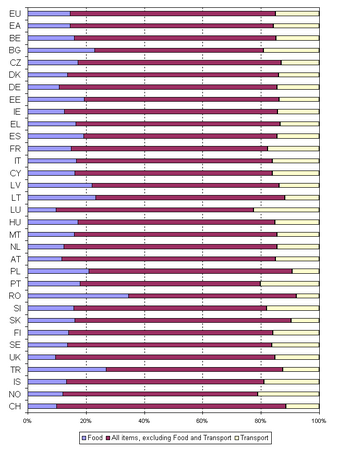Archive:HICP - household consumption patterns
The consumption patterns of households determine the relative importance (weight) of household monetary expenditure attached to each category of goods and services covered by the Harmonized index of consumer prices (HICP), a key measure of inflation in the European Union (EU). The impact on the index of any price change is proportional to the corresponding weight.
There is, however, no uniform basket which applies to all Member States. The structure of the weights may vary considerably from country to country, as well as between the HICP for an individual Member State and the average weighting structure of the EU or the euro area.
This article considers the weightings attached to the different categories of goods and services in HICPs in Member States, the euro area, and the EU as a whole. The data show that there are sharp differences in the attached weightings between Member States and the European aggregated data.
Main statistical findings
Consumption patterns in Member States
In 2008, in both the EU and the euro area, food, transport and housing - each accounting for around 15 % of consumption expenditure - had the largest weightings. A weight of around one tenth was attached to recreation and culture, although it is a little more important for the whole EU than for the euro area, while slightly lower weights were given to restaurants and hotels, which again were slightly higher for the EU (see Figure 1).
Within the national HICPs for the individual Member States, the weighting for food varied between 11 and 12 % for the United Kingdom, Luxembourg, and Germany but was as much as 37% for Romania.
The share for transport in household final monetary consumption expenditure (HFMCE) ranged from 8-10 % for Romania, Poland, and Slovakia, to 19-23% in Bulgaria, Portugal and Luxembourg. Consumption expenditure on recreation and culture ranged from 5% in Bulgaria, Portugal, Romania, and Greece to 15 % in the United Kingdom.
The weight for housing ranged from 8-9 % in Malta, Cyprus, Greece and Luxembourg, to 22-23% in Slovakia and Germany. In the housing category, it should be noted that HICPs reflect only monetary expenditure. Unlike national accounts or household budget surveys, they do not cover services provided by owner-occupied dwellings. This means that countries in which a larger proportion of the population lives in rented dwellings tend to have a larger weight for housing than countries in which a larger proportion of households live in their own dwellings.
Data sources and availability
HICP item weights are updated each year by the national statistical institutes using data from national accounts, household budget surveys and other administrative sources.
Country weights for HICPs are derived from national accounts data for household final monetary consumption expenditure. For the euro area, they reflect household final monetary consumption expenditure, expressed in euros, while for the other EU and European Economic Area (EEA) countries, the amounts are expressed in Purchasing power standard (PPS), an artificial currency unit which can buy the same amount of goods and services in each of the countries considered.
Within the euro area and EU, the weight of a Member State is its share of household final monetary consumption expenditure in the totals (see Figure 2).
The country weights used in 2008 were based on national accounts data for 2006 updated to December 2007 prices. For the euro area, weights in national currencies were converted into euros using the irrevocably locked exchange rates. For the EU, weights in national currencies were converted into PPSs. The weight of the euro area reflects its share in the EU total.
Context
HICPs are used for many purposes, such as indexing social benefits or contracts, or as inputs into various types of economic analyses. They are also used to monitor price stability in the euro area and as convergence criteria for countries which want to join the euro.
Crucially, the European Central Bank (ECB) considers them to be the the most appropriate measure for assessing price stability. The ECB considers the Monetary Union index of consumer prices (an HICP reflecting prices in the euro area) in setting its monetary policy. Its target is for inflation of below, but close to, 2 % over the medium term. Inflation above this level is assumed to trigger an interest rate hike.
Further Eurostat information
Publications
Other information
External links
- European Central Bank - Measuring inflation – the Harmonised Index of Consumer Prices (HICP), see: Weights

